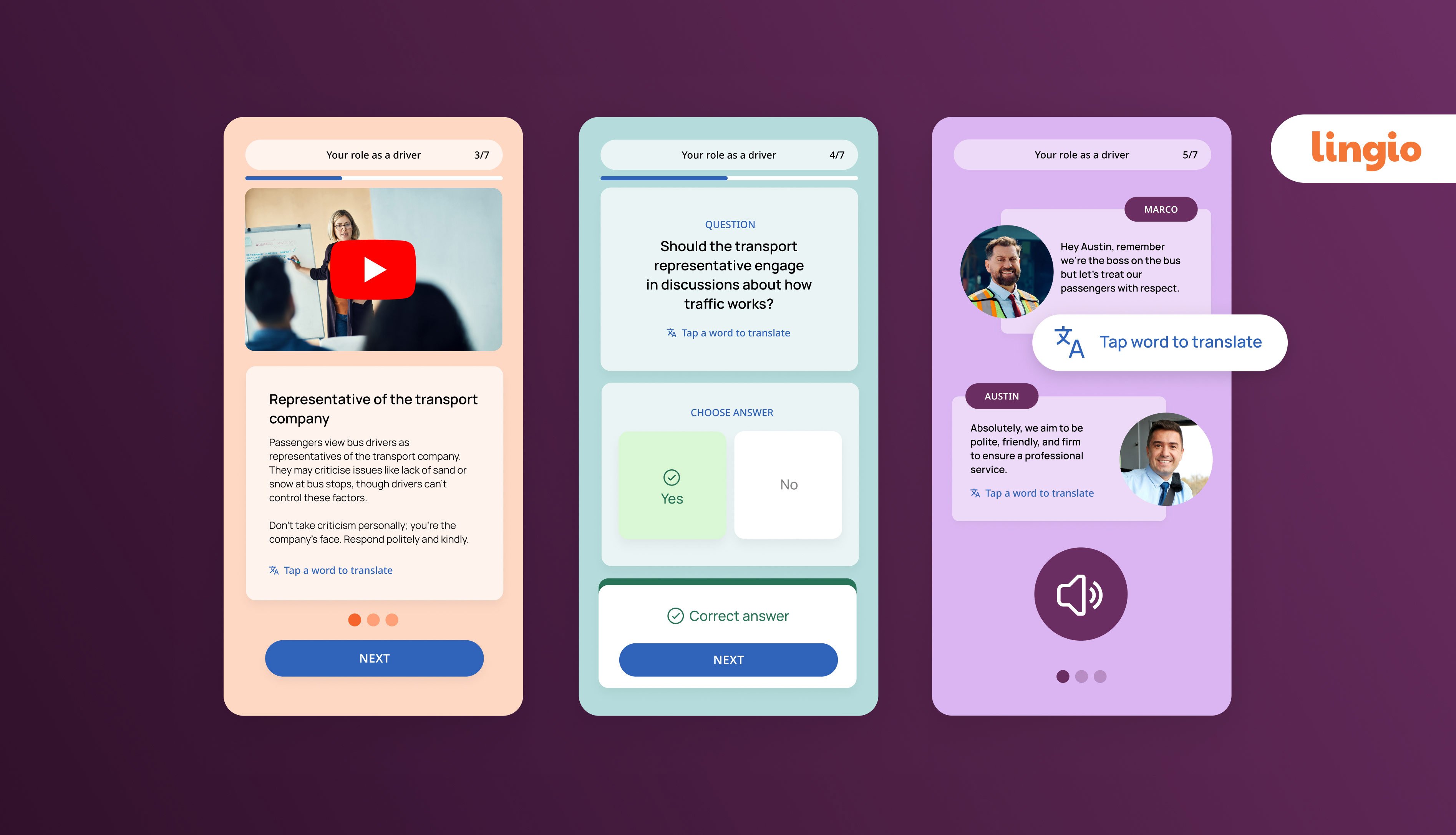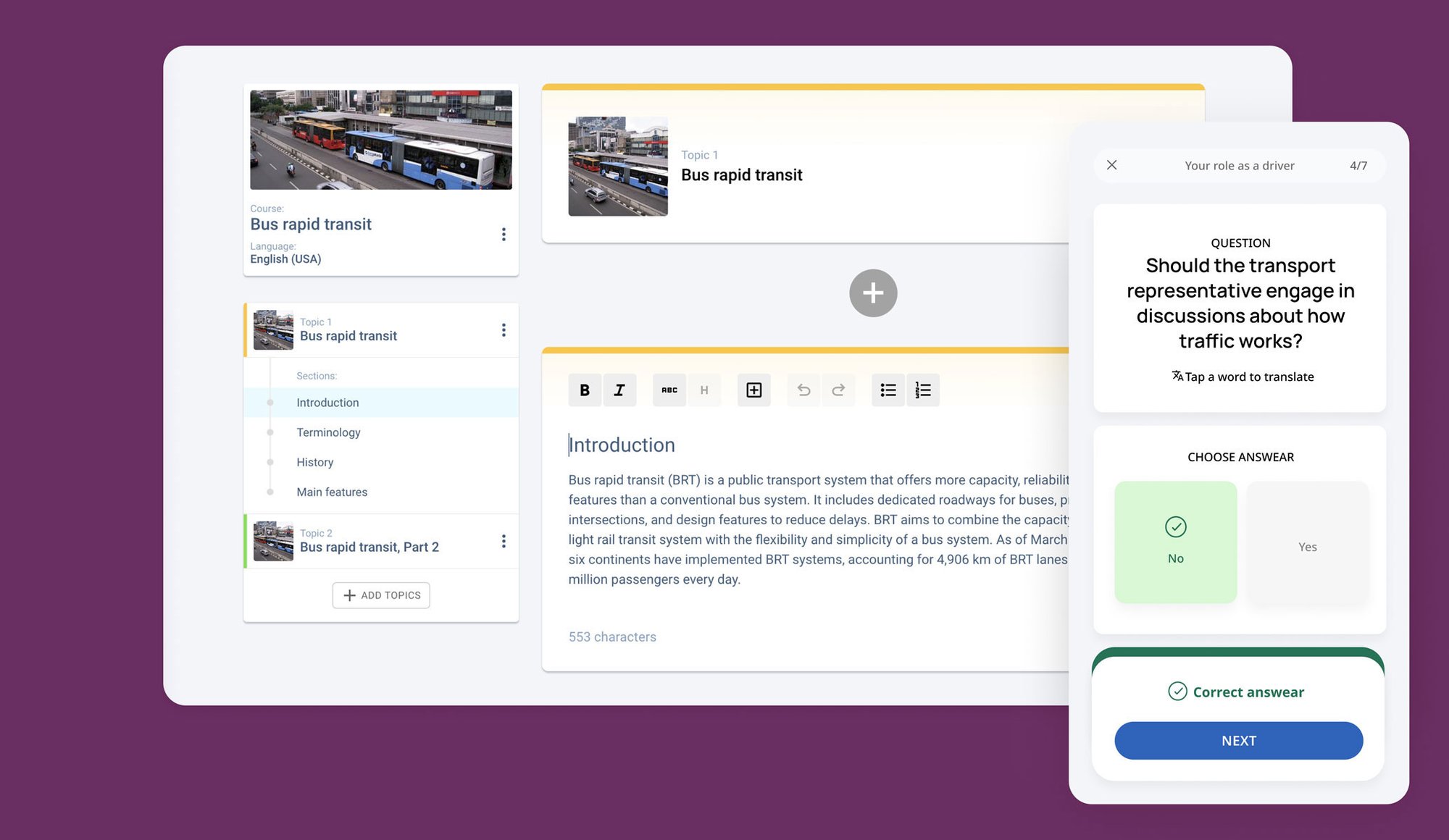8 best practices in designing compliance training
Let’s go through some of the best practices when it comes to designing an effective compliance training plan.

1. Incorporate interactive and engaging content
Using real-world scenarios, case studies, and interactive elements such as quizzes and simulations can transform training content from mundane to compelling. These methods bridge the gap between theoretical knowledge and practical application, allowing learners to see the direct relevance of compliance in their daily tasks.
By engaging with scenarios that mirror actual workplace challenges, employees can better grasp the consequences of non-compliance and the importance of adhering to regulations. Interactive, gamified content makes learning more enjoyable and also enhances retention, ensuring that the lessons learned will be applied effectively in real-world situations.
In fact, approximately 95% of employees prefer game-enhanced training methods over traditional methods. This approach fosters a proactive compliance company culture within the organisation, where employees aren’t just passive recipients of information but active participants in maintaining a safe and ethical workplace.
2. Customise training to specific roles and departments
By tailoring your employee training courses to address the unique needs, responsibilities, and compliance requirements of different groups within the organisation, you ensure that every team member receives learning material that’s directly relevant to their role. This approach increases the training's effectiveness and enhances engagement by demonstrating to employees the impact of compliance on their day to day operations.
Additionally, reviewing training entries for overlapping topics between departments can reveal opportunities for collaboration. These shared sessions optimise training efforts and promote interdepartmental relationships and understanding, highlighting how compliance issues and workflows impact various areas of the organisation.
3. Promote continuous learning and regular updates
The landscape of state and federal laws is ever-changing, and what was up-to-date yesterday might not be so tomorrow. This constant evolution means if you have legal teams and training developers, they need to be in close communication, ensuring that everyone's on the same page and no employee is left navigating with an outdated map.
Keeping training fresh and current is about more than just avoiding legal pitfalls. It's about nurturing a company culture of continuous learning and adaptation. Instead of cramming compliance training into a once-a-year marathon session that can overwhelm and quickly be forgotten, consider spreading it over the year. This can make learning more manageable, engaging, and - most importantly - effective. Training techniques like microlearning courses can help with this method of learning.
4. Utilise technology and e-learning tools
Today, engagement with information is predominantly through screens, so incorporating technology into employee compliance training programs makes learning more accessible and engaging. The introduction of training apps, cloud-based platforms, and mobile-based learning solutions like Lingio opens up a world of possibilities for compliance training. These tools allow for creating highly engaging training courses that employees can access anytime, anywhere, fitting learning seamlessly into their busy schedules.
Moreover, the speed at which digital technology enables updates to training content is invaluable, especially for compliance training, where timeliness is critical. Online learning tools simplify the process of updating courses or creating new ones, ensuring that employees have immediate access to the most current information.
Additionally, eLearning platforms like Lingio streamline tracking and reporting, allowing HR managers to quickly identify who has completed their training. This is crucial for staying ahead in industry audits and avoiding penalties.

5. Ensure accessibility and inclusivity
The diversity of learning styles and needs among staff necessitates a flexible approach to employee training. Traditional classroom settings and rigid schedules can exclude busy frontline workers, remote workers, or those who have other commitments that make attendance challenging. Moreover, long training sessions can disrupt work schedules and potentially require overtime arrangements, adding to the logistical and financial strain.
Online compliance training programs offer a practical solution to these challenges. They allow employees to engage with training materials on their own time, from any location, and at their own pace. Digital platforms also offer varied formats to cater to different learning styles, including videos, reading materials, and interactive assessments.
Beyond logistical accessibility, inclusivity also means designing training that respects and acknowledges all employees' diverse backgrounds and abilities. This includes ensuring that materials are accessible to those with disabilities, such as offering captioning for videos and screen reader-friendly content, and are available in multiple languages, if necessary. For example, with Lingio, users can translate industry terms in-app to 100+ languages. Creating an inclusive learning environment also involves presenting scenarios and compliance training examples that reflect a wide range of cultures, identities, and experiences, building a sense of belonging and respect.
6. Foster a culture of compliance
Embedding the principles of compliance into the organisational culture helps foster a culture of compliance. This involves more than just training. It's about making compliance a core value reflected in every action and decision.
Leadership should demonstrate a commitment to compliance that inspires others. Encourage open discussions about compliance, integrating it into day to day operations, and recognising those who uphold these values. Celebrate compliance achievements to motivate the entire team. By doing so, compliance becomes a shared responsibility, creating an environment where adherence to regulations and ethical behaviour is part of the organisation's DNA, ensuring long-term success and integrity.
7. Track and analyse training outcomes
If you’re wondering how to measure the effectiveness of a compliance training program, utilising metrics and feedback, such as engagement rates, assessment results, and employee performance, provides invaluable insights into how well the training is meeting its objectives. Many learning management systems, like Lingio, offer built-in analytics, allowing you to monitor who engages with the training. This data can highlight areas for improvement, enabling you to refine and enhance the training experience.
Encouraging a culture of feedback to track progress is also crucial. Detailed, constructive feedback on assessments helps reinforce learning. Likewise, inviting participants to share their thoughts on the training gives them a voice in the process and enables you to tailor your program to meet their needs better. By actively measuring and responding to the outcomes of your training, you ensure that your compliance program evolves continually, becoming more effective and engaging over time.
8. Involve and consult legal experts
The legal landscape constantly shifts, with new laws and regulations emerging regularly. By partnering with legal experts, you guarantee that your training material meets the current legal standards and anticipates future changes. Legal professionals can provide critical insights into complex regulatory requirements, helping to translate these into understandable and actionable course content for your employees. This collaboration ensures that your training is both informative and legally sound, reducing the risk of non-compliance and reinforcing your organisation's commitment to operating within the legal framework. Their expertise can be the difference between a standard compliance training program and one that truly prepares your team to navigate the complexities of compliance with confidence.








